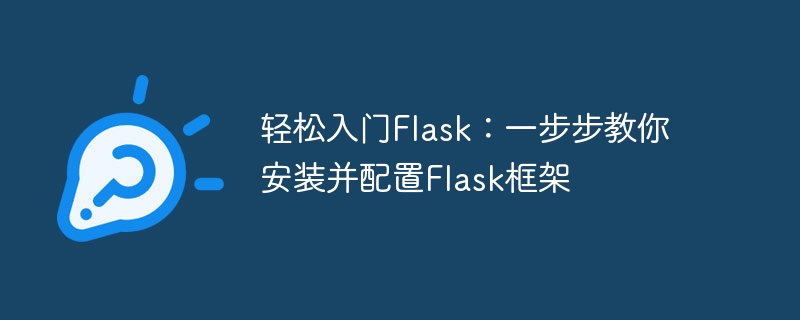

Get started with Flask easily: teach you step by step to install and configure the Flask framework, specific code examples are required
Introduction:
Flask is a simple and easy to learn framework Python web framework, due to its flexibility and ease of use, more and more developers choose to use Flask to build web applications. This article will teach you step by step how to install and configure the Flask framework, and provide specific code examples to help you quickly master the basic usage of Flask.
Step One: Install Flask
Before you start, you need to make sure that Python and pip are installed on your computer, because Flask is an extension module of Python. If you haven't installed it yet, you can download and install it from the Python official website.
Installing Flask is very simple, just run the following command in the terminal or command line:
pip install flask
If you encounter permission issues, you can try prefixing the command with sudo:
sudo pip install flask
After the installation is complete, you can start creating your first Flask application.
Step 2: Hello World
Create a Python file named app.py in your project directory and enter the following code in it:
from flask import Flask app = Flask(__name__) @app.route("/") def hello(): return "Hello World!" if __name__ == "__main__": app.run()
Above The code creates a Flask application called app and defines a route called hello. When accessing the root path "/", the hello function will be executed and "Hello World!" will be returned.
Save and run this file, you will see output similar to the following:
* Running on http://127.0.0.1:5000/ (Press CTRL+C to quit)
This means that the Flask application has successfully run on the local server, you can enter http://127.0.0.1:5000/ to access it.
Step Three: Routing and View Functions
A route is a URL address in a Flask application that tells Flask which function should be executed when it receives a user request. Routes can have variables, so you can return different results based on different variable values.
Modify the app.py file and add a new route and view function:
@app.route("/hello/") def say_hello(name): return f"Hello {name}!" @app.route("/add//") def add(num1, num2): result = num1 + num2 return f"The result is {result}"
In the above code, we defined two routes. The first route /hello/
Save and re-run the app.py file, then enter http://127.0.0.1:5000/hello/YourName in the browser to test the first route, enter http://127.0.0.1: 5000/add/2/3 to test the second route.
Step 4: Templates and static files
In actual web applications, we usually use a template engine to dynamically generate HTML pages. Flask has a built-in Jinja2 template engine, which can help us process templates more conveniently.
Create a folder named templates in your project directory, and create an HTML template file named index.html in it:
Modify the app.py file, use The render_template function renders this template:
from flask import render_template @app.route("/template///") def template_example(name, num1, num2): result = num1 + num2 return render_template('index.html', name=name, result=result)
In the above code, we define a new route /template/
Save and re-run the app.py file, and then enter http://127.0.0.1:5000/template/YourName/2/3 in the browser to view the results of template rendering.
In addition to templates, Flask also allows you to use static files, such as CSS and JavaScript, in your application. Just create a folder named static in the project directory and put the static files in it. In HTML templates, you can use the url_for function to reference static files.
Conclusion:
Through the introduction of this article, you have learned how to install and configure the Flask framework, and mastered the basic usage of Flask. Next, you can move on to learn more advanced features of Flask, such as database operations and form validation. Flask has strong expansion capabilities and can meet the needs of different projects. I wish you success in learning and applying Flask!
The above is the detailed content of Get started with Flask easily: teach you step by step how to install and configure the Flask framework. For more information, please follow other related articles on the PHP Chinese website!